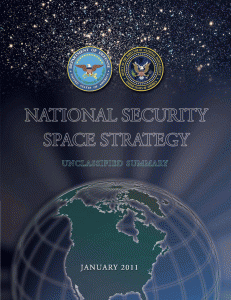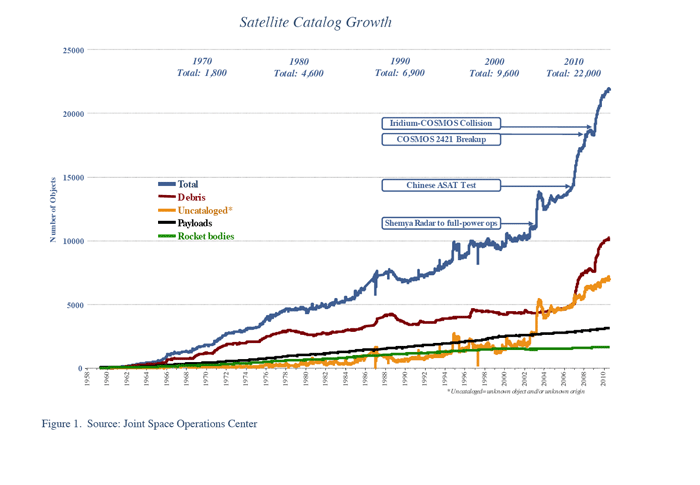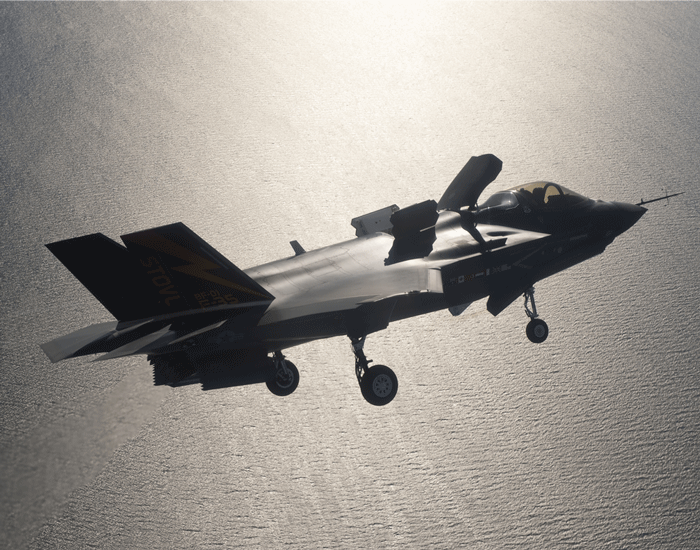04/27/2011 – In late March 2011, prior to the christening of the LPD-24 at the Ingalls Shipyards in Pascagoula, Mississippi, Second Line of Defense interviewed the LPD 17 program manager, Doug Lounsberry. Lounsberry provided an overview to the challenges of building this class of ship and the advantages, which the ship brings to the USN-USMC team.
SLD: Could you give us some background on the LPD 17 and the Ingalls Shipbuilding?
Lounsberry: It’s the first LPD that we built; we built other big deck Amphibs, the LHAs, the LHDs, but we never built an LPD class before. We actually didn’t win the contract; Avondale with Bath Iron Works won the contract. And then, in the Northrop Grumman consolidation, the intent at the time was Avondale was going to continue on with the LPDs, we were going to continue on over here with our platforms.
At the time Avondale was also finishing the Sea Lift contract and Polar tanker contracts so the decision was made based on facilities and resource availability to build some of the LPDs at Avondale and some in Pascagoula. Another driving decision was the complexity of the ship. Because of the highly automated systems on the ship, we felt we could utilize some of the Electronics expertise we had developed over the years on our surface combatant programs to help sort out some of the issues in this new class of ship we were seeing. As a result, LPD’s are being constructed at two sites. As you know, now we’re going through another big roll down in the shipbuilding industry. It appears that we will wind down our ship construction activities at Avondale by 2013, so we will then be building all the LPDs in Pascagoula. We have two in construction in Avondale right now, LPD 23 and 25. We just launched 23. 25 was just moved to position two; we’ll finish construction there and launch her in about 12 months or so, then about a year after that she will deliver in Avondale.
Lounsberry During the SLD Interview, March 2011
Photo Credit: SLD
SLD: What is the current planning for the number of ships for the LPDs?
Lounsberry: The original class was planned to be at least 12 ships. Right now we have been awarded 10 LPD’s, with LPD-26 just recently awarded to us to build.
SLD: How long does it take to go from keel to launch on a ship like this?
Lounsberry: It’s about four years right now.
SLD: And the supply chain for the ship is national? It’s international?
Lounsberry: Actually, there are some international aspects to it. As the Navy has sized down to significantly fewer ships from the 600-ship fleet pursued during the Reagan era, the industrial base has shrunk along with it. Also, a lot of our suppliers, like Caterpillar have gone overseas to find more business, Caterpillar particularly is doing a lot of business over in China. So now, where the American shipbuilder used to be one of the prime customers for some of these big manufacturers, now, with fewer orders, we have to get in the manufacturing line like everyone else, and wait our turn.
We’re seeing things now that we never saw before. For instance, on the diesel engines, we have always had a pretty long lead-time on the diesel engines, but you could get a typical long lead contract and get your engines in ahead of construction of the ship. Now, we’ve had to restructure some of that a little bit, and the Navy’s had to become a little bit more flexible. When we went to buy the engines on LPD-25, and again on 26, we had to have advanced long lead-time material to give our engine suppliers, because they had to buy their bearings and rods from suppliers that are also serving some markets overseas, which meant longer lead time for parts for our engine suppliers and consequently longer time for the engines. So, it stretched out the length of some of these big procurements a little bit longer. And I perhaps that’s the way business is going to be, as long as the procurement volumes are significantly reduced.
SLD: As DOD significantly reduces the platforms it buys; it is going to be a less significant buyer shaping supply chain realities.
Lounsberry: It’s very interesting if you go back and look, even 15 years ago. When we were building a lot more ships, the availability for suppliers for components, the base was a lot bigger, that meant a lot more competition and a lot more innovation in my opinion. In some areas, we’re down to one or two vendors now. This limits our ability to go do some things with our suppliers to get the prices down, and again, I think stifles innovation.
When we were building a lot of ships, the suppliers had to build a lot of their components to military standards. As that customer’s orders decreased, they were servicing more commercial contracts; their production lines were set up for more commercial grade products. Doing a one off mill spec item becomes a lot more expensive; and they’re not as interested.
SLD: Have you had any single points of failure where somebody goes away right in the middle of a construction effort?
Lounsberry: Yes. When a vendor will or cannot continue to supply a product or service we have to work with another vendor to supply or take over another vendor’s business, which puts additional stresses on some of the schedules for major ship components.
SLD: And that slowed everything down?
Lounsberry: Yes, and that drove quite a bit of “work arounds” to do things out of sequence which is more expensive for us and more time consuming in delivering completed ships.
SLD: So your folks, your workers, your engineers were going into the supply chain, in this case, and trying to shape the products that you wanted to accept.
Lounsberry: More importantly we were helping them get some of these production lines stabilized again by reviewing component schedules and working with them to incrementally accept pieces of equipment a little at a time to minimize overall impacts.
SLD: Let us focus on the ship itself.
Lounsberry: As I said earlier, this was the first LPD class that I had been involved with at this shipyard. We built LHDs, LHAs, and at the other end of the spectrum, Destroyers and Cruisers. It’s a well deck ship, kind of like the LHDs were, but it has different capabilities, the ship’s a lot faster and stealthier. When you look at some of the previous LSD class ships that the Navy has procured, it has a lot more warfare capability as far as command and control is concerned. I was very impressed with the first ship when I went on sea trials. I spent most of my time on Destroyers and Cruisers. So I was expecting a very slow dull ride on sea trials. When we got LPD-17 up to speed, and did the turns, I was on the bridge, and I tell you what, you could’ve been on a cruise ship. That’s how smooth that ship ran. And speed was not an issue for this ship. I was very pleasantly surprised.
SLD: Why? Does it have new features or a new hull design?
Lounsberry: You can look at the ship and see that it has the RCS design on the outer hull.
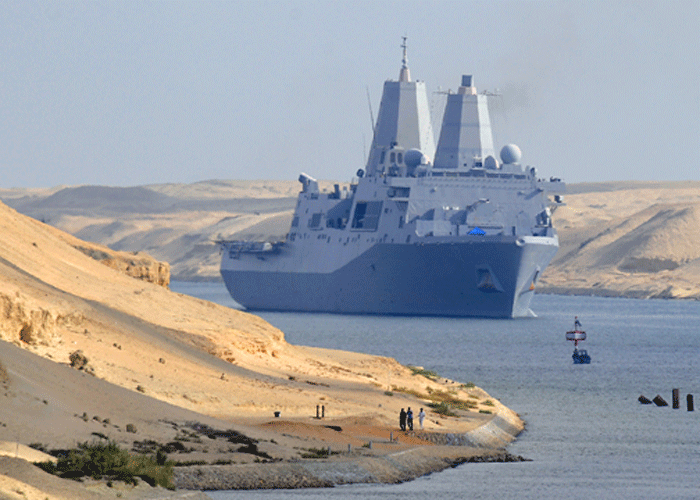
The USS San Antonio Transiting the Suez Canal
Credit: US Naval Forces, 5th Fleet Public Affairs, 9/23/08
SLD: What’s an RCS?
Lounsberry: The reduced radar cross-section, which is a design, that helps keep it less detectable by radars.
SLD: Trying to make it less of a target.
Lounsberry: It’s harder to pick up on radar. And I’m not a naval architect, but I can tell you that the time they spent on the hull form to make it a stable platform was well worth the time. And the ballast capability of it really impressed me too, how quickly we could ballast down and ballast back up.
SLD: What’s the tonnage of this ship?
Lounsberry: Roughly twenty-eight thousand tons.
SLD: The yard has built destroyers and there seems to be synergy between some of your destroyer work and the LPD-17.
Lounsberry: It has a lot of the same capabilities that our Destroyer does, as far as command and control goes. Its capabilities could be useful as a Navy command and control ship. As far as the rest of the command and control systems, the ship has very good modern state-of-the-art surveillance, navigation, and communication.
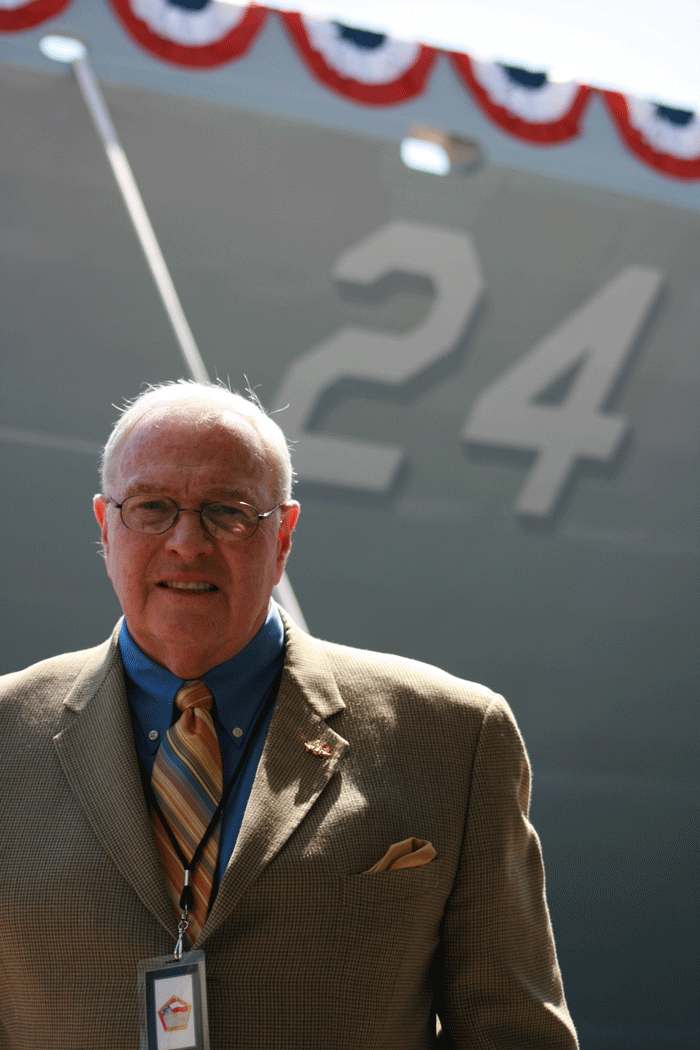
SLD’s Ed Timperlake in Front of the LPD 24 Prior to the Ship’s Christening
Photo Credit SLD 2011
SLD: Well, let’s just focus on that for a moment, because the older ships, it was always kind of an add-on. But here, you’ve built into the structure of the ship, the modern command and control capability. Is that true in terms of the architecture itself?
Lounsberry: Yes. It’s part of the base ship itself. It’s not your grandfather’s Amphibious Ship. It could be considered, in my view, as a candidate for the lead ship of an ARG, because it has significant command and control capability.
Lounsberry: The flexibility for carrying, retaining, launching, recovering aircraft, just like you said, Ospreys, the big Hueys, the smaller helos. As far as the Marine Corps equipment goes, the ability to carry two LCACs (Landing Craft Air Cushion class) and all their landing equipment.
SLD: Could you service LCSs off this thing or other ships?
Lounsberry: Absolutely. It has significant fuel capability onboard. One of the concepts is the clustering of ships that can usually support each other on the logistical side also.
SLD: Let us go back to the question of the challenge of manufacturing this ship.
Lounsberry: Initially, the design was not mature, and we started construction without a final design, and as design changes were made, it would slow down construction to accommodate the changes. As I said this is a very complex warship with a lot of interfaces. We had to finish the design on the ship while we were trying to build the first two, with a third already starting construction. Because of the complexity of the ship, particularly on the electronics side, the decision was made to pull the first ship over to Pascagoula once it was seaworthy, because we had the DDG class electronic experts here from our DDG class ship. We believe we know how to do that part of the combat system electronic integration as well or better than anyone in the country.
SLD: When you inherited the ship, you had the opportunity basically to link to your destroyer experience on combat systems integration.
Lounsberry: Right.
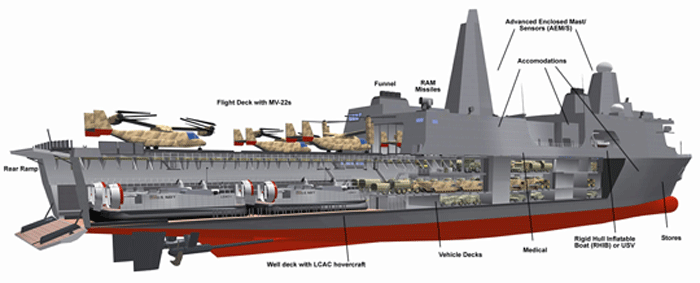
http://www.defenseindustrydaily.com/lpd17-san-antonio-class-the-usas-new-amphibious-ships-updated-02322/
SLD: You also had an opportunity to say okay, the program really needs to be recast, you need to simplify the ship, and you need to mature the design. But maturing the design, it obviously must mean in part making some decisions that some things are just too complex for this ship, from a necessity perspective, to deliver the capability the USN wanted.
Lounsberry: Sure, a good example was eliminating signals that notified the command center that someone had activated an eyewash, not really a necessary feature and it complicates control systems by adding unnecessary signals. And also, a product like this takes a relatively long time to go through the manufacturing process. It’s critical to hit that sweet spot where the overlay from one ship to the next, so you can roll those crews from ship to ship at the appropriate phases of construction and maximize learning. The added dimensions of increased technology meant more integration and a different approach to the construction process and how we moved those crews.
SLD: I have a sense that the drive to reduce manpower by technology also has created problems.
Lounsberry: We were talking earlier about how complex it was. I believe early in the design with a tremendous focus on overall life cycle costs, there were decisions made to automate everything possible in order to reduce crew size. I think they may have gone a little overboard in that area as was demonstrated by the eye wash alarms. Just because technologically you can engineer something and build, doesn’t necessarily mean you should. But that’s the level of complexity driven into this design. And we started weeding some of that out as we descoped, while not eliminating essential improvements in mission capability.
SLD: The LPD-17 seems a kind of mini-Destroyer.
Lounsberry: I like to think of it as a Destroyer with larger muscles.
SLD: Could you describe the advantages accrued from the learning curve in building this ship. We seem to have an approach that highlights getting the building process to the sweet spot and then stop buying the platform.
Lounsberry: One measure of the learning curve can be seen in this way. We have delivered five of these ships; we have four in construction right now. Between the first ship LPD 17 end cost and the LPD-25 right now, we’ve taken 2.5 million man-hours out of the construction; we only have potentially one, maybe two more of the class to build unless something changes.
SLD: Folks also seem to forget the challenge of dealing with hurricanes and the impact on your work force and the construction challenges that has posed.
Lounsberry: Because of the hurricanes, our workforce that remained with us was stressed and we also lost a lot of our workforce both here and at Avondale. We ended up having to outsource units to subcontractors to do the steelwork on 22 and 23. And that was not a very efficient way to do it, until we could build our workforce back up. We’re back up to speed now; our workforce has the experience with these ships now to really crank them out. If we could build more of these, there’s no telling where the price on this could go. We are now on a very good learning curve, which has allowed us to get the cost of these ships down. Material costs are the material costs, the overhead costs, you can control somewhat, but vessel labor is where we can really make the biggest difference.
SLD: And the size and flexibility of these ships argues for building more. It is also a platform, which can evolve with transformation of robotic technology. You could carry tons of robotic vehicles on these ships and deploy them. The autonomous mine vehicle, which we discussed earlier.
Lounsberry: There are tremendous possibilities with this platform based on its designed-in flexibility and capability.
SLD: And what about the logs and sustainment approach of the ship?
Lounsberry: There’s a lot going on in those particular areas on this class of ship right now, the first of these ships is out in the fleet now. They have some new components that had never been deployed before and as they use some of those certain reliability problems have arisen. Typically on the first of a class of ship, you’ll build the ship completely, you’ll test it, you’ll send it out there, run it through its motions, get feedback and then use lesson learned to flow, back into the design. Because of the nature of this particular contract, there were limited opportunities to get detailed feedback early to apply to the follow ships. So, it was four or five ships down the line, before they shook out the maintenance issues. We are working closely with our Navy customers to get these issues ironed out and drive those improvements into the ships now under construction. We have a tremendous focus on first time quality at the shipyard and we are seeing the benefits of that also.
Right now, there’s a lot of work going on, our lead engineer right now used to be the Program Manager on this program, and is working directly with the Navy. They’ve developed a very robust reliability model. They’re putting in all of the components down through the piece part level for the propulsion system where they’ve had some issues.The Navy and the shipbuilder are spending a lot of time on reliability, sustainability. The Navy is finally getting up to speed on looking at failure data and stocking up their supply system. So that’s starting to really get momentum now.
SLD: What about the future opportunities for this ship?
Lounsberry: As I said earlier, we seem to only have one more of these potentially in the queue, LPD-27. Unfortunately, we’re getting into that sweet spot now with these ships where we’ve ironed out a lot of the issues. We’re on a good learning curve. If we could keep going on these things, there’s no telling where we could take these ships relative to reductions in vessel labor, and overall improvements in operational excellence.


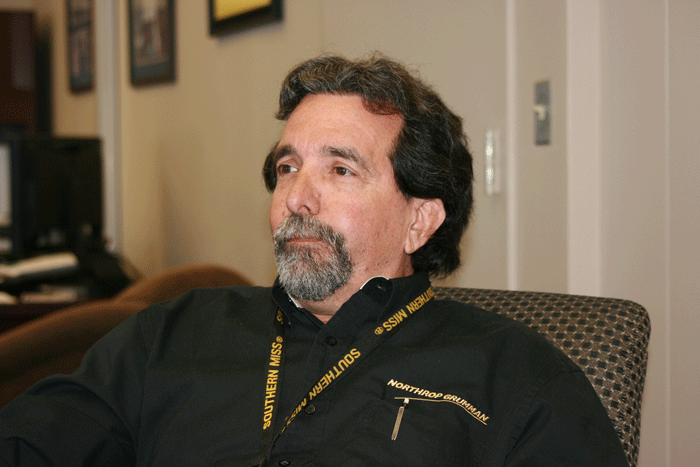
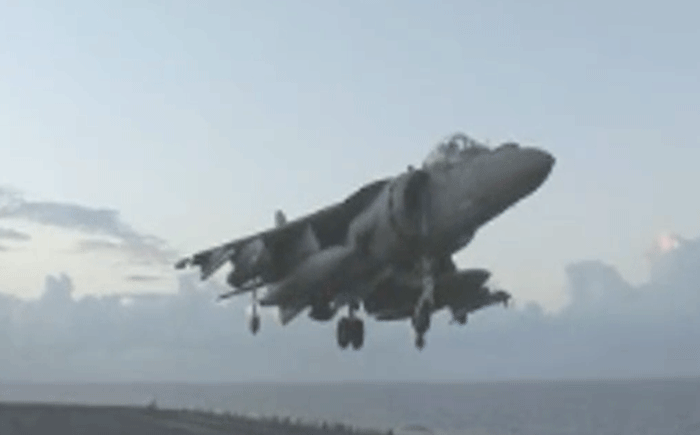
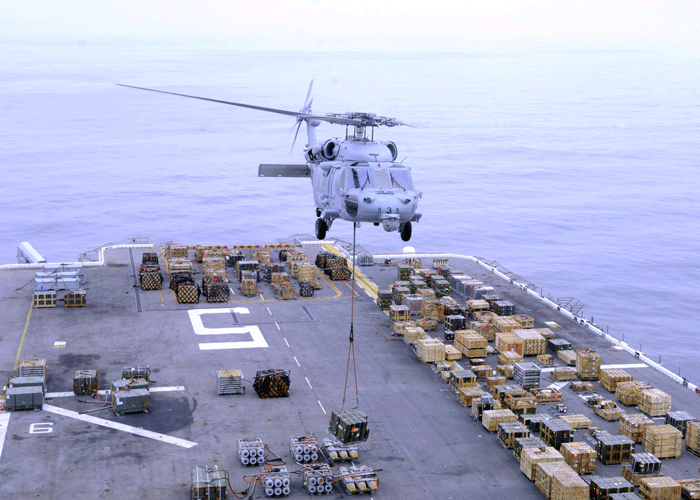
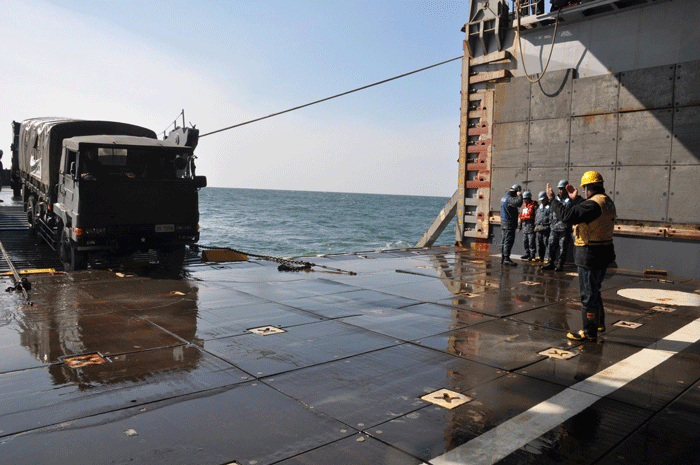 A sailor aboard the amphibious dock landing ship USS Tortuga guides a Japan Ground Self-Defense Force truck carrying humanitarian supplies into the well deck of the ship. Tortuga is transporting the equipment to support Operation Tomodachi, a humanitarian assistance mission in the aftermath of a 9.0 magnitude earthquake and subsequent tsunami.
A sailor aboard the amphibious dock landing ship USS Tortuga guides a Japan Ground Self-Defense Force truck carrying humanitarian supplies into the well deck of the ship. Tortuga is transporting the equipment to support Operation Tomodachi, a humanitarian assistance mission in the aftermath of a 9.0 magnitude earthquake and subsequent tsunami.


